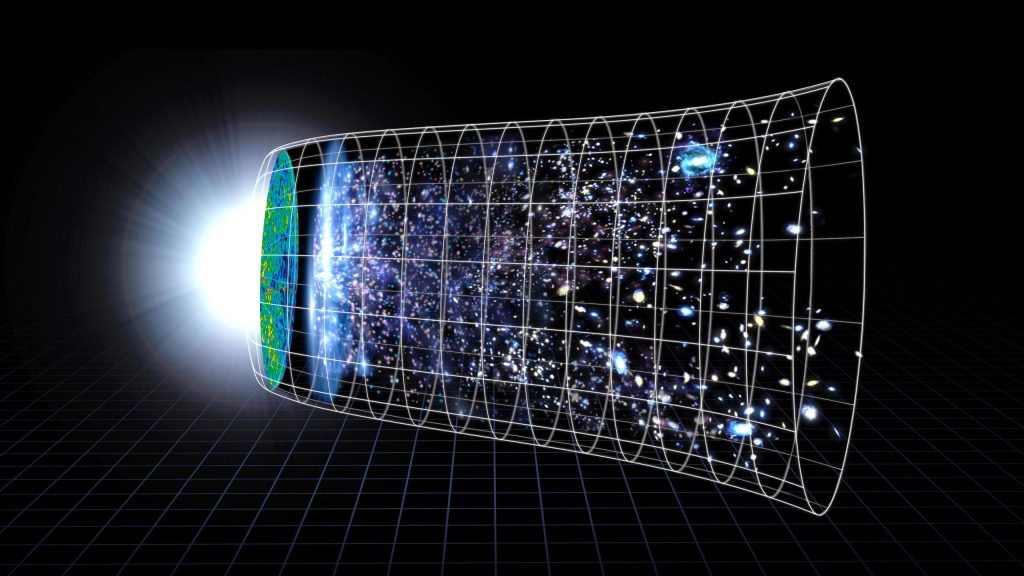
Eine Darstellung der Entwicklung des Universums über 13,77 Milliarden Jahre. Ganz links zeigt den ersten Moment, den wir jetzt erkunden können, als eine Periode der „Inflation“ eine Welle exponentiellen Wachstums im Universum auslöste. (Das Volumen wird durch die vertikale Ausdehnung des Gitters in dieser Zeichnung dargestellt.) Im Laufe der folgenden Milliarden Jahre verlangsamte sich die Expansion des Universums allmählich, da die Materie im Universum durch die Schwerkraft auf sich selbst geschoben wurde. Vor kurzem hat die Expansion begonnen, sich wieder zu beschleunigen, da die abstoßenden Effekte der Dunklen Energie die Expansion des Universums dominieren. Bildnachweis: Goddard Space Flight Center der NASA
Drei Jahrzehnte Weltraumteleskop-Beobachtungen konvergieren um einen genauen Wert der Hubble-Konstante
Die Wissenschaftsgeschichte wird festhalten, dass die Suche nach der Expansionsrate des Universums der große heilige Gral der Kosmologie im 20. Jahrhundert war. Ohne Beobachtungsnachweise für Raumausdehnung, -kontraktion oder -stabilität hätten wir keinen Hinweis darauf, ob das Universum kommt oder geht. Außerdem hätten wir keine Ahnung, wie alt er war – oder tatsächlich, ob das Universum ewig wäre.
Die erste Arbeit dieser Entdeckung kam, als der amerikanische Astronom Edwin Hubble vor einem Jahrhundert unzählige Galaxien außerhalb unserer Heimatgalaxie entdeckte,[{“ attribute=““>Milky Way. And, the galaxies weren’t standing still. Hubble found that the farther a galaxy is, the faster it appears to be moving away from us. This could be interpreted as the uniform expansion of space. Hubble even said that he studied the galaxies simply as “markers of space.” However, he was never fully convinced of the idea of a uniformly expanding universe. He suspected his measurements might be evidence of something else more oddball going on in the universe.
“You are getting the most precise measure of the expansion rate for the universe from the gold standard of telescopes and cosmic mile markers.” — Nobel Laureate Adam Riess
For decades after Hubble, astronomers have toiled to nail down the expansion rate that would yield a true age for the universe. This required building a string of cosmic distance ladders assembled from sources that astronomers have a reasonable confidence in their intrinsic brightness. The brightest, and therefore farthest detectable milepost markers are Type Ia supernovae.
When the Hubble Space Telescope was launched in 1990 the universe’s expansion rate was so uncertain that its age might only be 8 billion years or as great as 20 billion years.
After 30 years of meticulous work using the Hubble telescope’s extraordinary observing power, numerous teams of astronomers have narrowed the expansion rate to a precision of just over 1%. This can be used to predict that the universe will double in size in 10 billion years.
The measurement is about eight times more precise than Hubble’s expected capability. But it’s become more than just refining a number to cosmologists. In the interim the mystery of dark energy pushing the universe apart was discovered. To compound things even further, the present expansion rate is different than it is expected to be as the universe appeared shortly after the big bang.
You think this would frustrate astronomers, but instead it opens the door to discovering new physics, and confronting unanticipated questions about the underlying workings of the universe. And, finally, reminding us that we have a lot more to learn among the stars.

This collection of 36 images from NASA’s Hubble Space Telescope features galaxies that are all hosts to both Cepheid variables and supernovae. These two celestial phenomena are both crucial tools used by astronomers to determine astronomical distance, and have been used to refine our measurement of the Hubble constant, the expansion rate of the universe.
The galaxies shown in this photo (from top row, left to bottom row, right) are: NGC 7541, NGC 3021, NGC 5643, NGC 3254, NGC 3147, NGC 105, NGC 2608, NGC 3583, NGC 3147, Mrk 1337, NGC 5861, NGC 2525, NGC 1015, UGC 9391, NGC 691, NGC 7678, NGC 2442, NGC 5468, NGC 5917, NGC 4639, NGC 3972, The Antennae Galaxies, NGC 5584, M106, NGC 7250, NGC 3370, NGC 5728, NGC 4424, NGC 1559, NGC 3982, NGC 1448, NGC 4680, M101, NGC 1365, NGC 7329, and NGC 3447.
Credit: NASA, ESA, Adam G. Riess (STScI, JHU)
Hubble Reaches New Milestone in Mystery of Universe’s Expansion Rate
NASA’s Hubble Space Telescope has completed a nearly 30-year marathon by calibrating more than 40 “milepost markers” of space and time to let scientists precisely calculate the expansion rate of the cosmos — a mission with a plot twist.
Pursuit of the universe’s expansion rate began in the 1920s with measurements by astronomers Edwin P. Hubble and Georges Lemaître. In 1998, this led to the discovery of “dark energy,” a mysterious repulsive force accelerating the universe’s expansion. In recent years, thanks to data from Hubble and other telescopes, astronomers found another strange twist: a discrepancy between the expansion rate as measured in the local universe compared to independent observations from right after the big bang, which predict a different expansion value.
The cause of this discrepancy remains a mystery. But Hubble data, encompassing a variety of cosmic objects that serve as distance markers, support the idea that something weird is going on, possibly involving brand new physics.
“You are getting the most precise measure of the expansion rate for the universe from the gold standard of telescopes and cosmic mile markers,” said Nobel Laureate Adam Riess of the Space Telescope Science Institute (STScI) and the Johns Hopkins University in Baltimore, Maryland.
Riess leads a scientific collaboration investigating the universe’s expansion rate called SHOES, which stands for Supernova, H0, for the Equation of State of Dark Energy. “This is what the Hubble Space Telescope was built to do, using the best techniques we know to do it. This is likely Hubble’s magnum opus, because it would take another 30 years of Hubble’s life to even double this sample size,” Riess said.
Riess’s team’s paper, to be published in the Special Focus issue of The Astrophysical Journal reports on completing the biggest and likely last major update on the Hubble constant. The new results more than double the prior sample of cosmic distance markers. His team also reanalyzed all of the prior data, with the whole dataset now including over 1,000 Hubble orbits.
When NASA conceived of a large space telescope in the 1970s, one of the primary justifications for the expense and extraordinary technical effort was to be able to resolve Cepheids, stars that brighten and dim periodically, seen inside our Milky Way and external galaxies. Cepheids have long been the gold standard of cosmic mile markers since their utility was discovered by astronomer Henrietta Swan Leavitt in 1912. To calculate much greater distances, astronomers use exploding stars called Type Ia supernovae.
Combined, these objects built a “cosmic distance ladder” across the universe and are essential to measuring the expansion rate of the universe, called the Hubble constant after Edwin Hubble. That value is critical to estimating the age of the universe and provides a basic test of our understanding of the universe.
Starting right after Hubble’s launch in 1990, the first set of observations of Cepheid stars to refine the Hubble constant was undertaken by two teams: the HST Key Project led by Wendy Freedman, Robert Kennicutt and Jeremy Mould, Marc Aaronson and another by Allan Sandage and collaborators, that used Cepheids as milepost markers to refine the distance measurement to nearby galaxies. By the early 2000s the teams declared “mission accomplished” by reaching an accuracy of 10 percent for the Hubble constant, 72 plus or minus 8 kilometers per second per megaparsec.
In 2005 and again in 2009, the addition of powerful new cameras onboard the Hubble telescope launched “Generation 2” of the Hubble constant research as teams set out to refine the value to an accuracy of just one percent. This was inaugurated by the SHOES program. Several teams of astronomers using Hubble, including SHOES, have converged on a Hubble constant value of 73 plus or minus 1 kilometer per second per megaparsec. While other approaches have been used to investigate the Hubble constant question, different teams have come up with values close to the same number.
The SHOES team includes long-time leaders Dr. Wenlong Yuan of Johns Hopkins University, Dr. Lucas Macri of Texas A&M University, Dr. Stefano Casertano of STScI and Dr. Dan Scolnic of Duke University. The project was designed to bracket the universe by matching the precision of the Hubble constant inferred from studying the cosmic microwave background radiation leftover from the dawn of the universe.
“The Hubble constant is a very special number. It can be used to thread a needle from the past to the present for an end-to-end test of our understanding of the universe. This took a phenomenal amount of detailed work,” said Dr. Licia Verde, a cosmologist at ICREA and the ICC-University of Barcelona, speaking about the SHOES team’s work.
The team measured 42 of the supernova milepost markers with Hubble. Because they are seen exploding at a rate of about one per year, Hubble has, for all practical purposes, logged as many supernovae as possible for measuring the universe’s expansion. Riess said, “We have a complete sample of all the supernovae accessible to the Hubble telescope seen in the last 40 years.” Like the lyrics from the song “Kansas City,” from the Broadway musical Oklahoma, Hubble has “gone about as fur as it c’n go!”
Weird Physics?
The expansion rate of the universe was predicted to be slower than what Hubble actually sees. By combining the Standard Cosmological Model of the Universe and measurements by the European Space Agency’s Planck mission (which observed the relic cosmic microwave background from 13.8 billion years ago), astronomers predict a lower value for the Hubble constant: 67.5 plus or minus 0.5 kilometers per second per megaparsec, compared to the SHOES team’s estimate of 73.
Given the large Hubble sample size, there is only a one-in-a-million chance astronomers are wrong due to an unlucky draw, said Riess, a common threshold for taking a problem seriously in physics. This finding is untangling what was becoming a nice and tidy picture of the universe’s dynamical evolution. Astronomers are at a loss for an explanation of the disconnect between the expansion rate of the local universe versus the primeval universe, but the answer might involve additional physics of the universe.
Such confounding findings have made life more exciting for cosmologists like Riess. Thirty years ago they started out to measure the Hubble constant to benchmark the universe, but now it has become something even more interesting. “Actually, I don’t care what the expansion value is specifically, but I like to use it to learn about the universe,” Riess added.
NASA’s new Webb Space Telescope will extend on Hubble’s work by showing these cosmic milepost markers at greater distances or sharper resolution than what Hubble can see.
Reference: “A Comprehensive Measurement of the Local Value of the Hubble Constant with 1 km/s/Mpc Uncertainty from the Hubble Space Telescope and the SH0ES Team” by Adam G. Riess, Wenlong Yuan, Lucas M. Macri, Dan Scolnic, Dillon Brout, Stefano Casertano, David O. Jones, Yukei Murakami, Louise Breuval, Thomas G. Brink, Alexei V. Filippenko, Samantha Hoffmann, Saurabh W. Jha, W. D’arcy Kenworthy, John Mackenty, Benjamin E. Stahl and Weikang Zheng, Accepted, The Astrophysical Journal.
arXiv:2112.04510
The Hubble Space Telescope is a project of international cooperation between NASA and ESA (European Space Agency). NASA’s Goddard Space Flight Center in Greenbelt, Maryland, manages the telescope. The Space Telescope Science Institute (STScI) in Baltimore, Maryland, conducts Hubble science operations. STScI is operated for NASA by the Association of Universities for Research in Astronomy in Washington, D.C.

„Pop-Kulturaholic. Web-Nerd. Engagierter Social-Media-Praktiker. Reisefanatiker. Schöpfer. Food-Guru.“

/cdn.vox-cdn.com/uploads/chorus_asset/file/24924650/236780_Google_AntiTrust_Trial_Custom_Art_CVirginia__0000_4.png)




More Stories
Die Federal Aviation Administration fordert eine Untersuchung des Misserfolgs bei der Landung der Falcon-9-Rakete von SpaceX
Identische Dinosaurier-Fußabdrücke auf zwei Kontinenten entdeckt
SpaceX startet 21 Starlink-Satelliten mit einer Falcon 9-Rakete von Cape Canaveral aus – SpaceflightNow